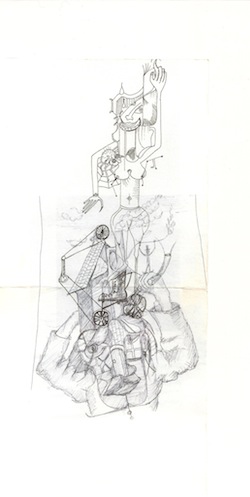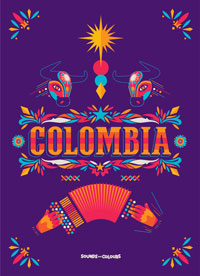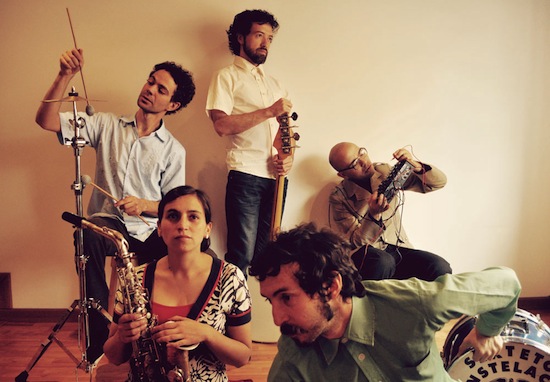Latin America is enjoying something of a cultural renaissance. It’s not so much that the Southlands have found themselves devoid of art or music until now – more that the narrow perception held by the global majority of a deprived, pseudo-primitive, Medellín-ruled dystopia is being rightly challenged. Having claimed the 2014 Olympics and World Cup, it’s plain to see the wheels in motion.
But change is not exclusive to Brazil; and, while tourism to Peru and Argentina (the latter bolstered, certainly, in no small part by Total Wipeout) have been on the up in recent years, it is their temperamental cousin Colombia that now finds its self increasingly centre stage.
Russell Slater is the editor of Sounds & Colours magazine, dedicated to South American culture, and of the recently published collection Sounds & Colours: Colombia – an expertly collated volume of musings on its art, music, film, literature and politics, with authoritative and representative contributions in myriad forms. Not least of all from Russell himself and from Tom Fielding, whose book <a href="http://www.penguin.co.uk/nf/Book/BookDisplay/0,,9781846145834,00.html" target"new">Short Walks from Bogotá: Journeys in the new Colombia was also published this year.
Emulating the country from which it derives its name, Colombia the book is defiant in the face of being labeled as any one thing: alongside the text there are not only photographs and illustrations, but also a CD of Colombian music that – rather than being an added extra – makes Slater’s book a uniquely immersive experience, more informative and true to form than any work of pure non-fiction writing on the subject.
I first came across the work of Eblis Javier Álvarez as Frente Cumbiero’s guitarist, playing psychedelic riffs that meshed with the fiery clarinet surges of Marco Fajardo to create a visceral power that doesn’t exist in much modern Latin American music. So many groups treat the traditional as sacred, afraid to mess with a formula that has already been around too long. This was not the case with Frente Cumbiero. Later when I heard Meridian Brothers I felt confused at first. This was Álvarez’s solo project; it had the same love for tropical music as Frente Cumbiero but it came from a different direction. This was someone who clearly wanted to experiment and at first it created a barrier. It was hard to relate to his voice, which was often effected and carried little melody, a detached Vincent Price narration floating around in the mix. After a while it became something familiar, I began to understand the lyrics and the nuances in the production, and the subtle differences in texture and rhythm, became more prominent. The character of the songs came through, revealing a completely unique aesthetic that kept pulling me back in for more.
The final important project in Álvarez’s career is Los Pirañas, an instrumental tropical punk band. Featuring Álvarez on guitar along with Mario Galeano on bass and Pedro Ojeda on drum (both of
whom also play in Frente Cumbiero), the trio formed as a live group, releasing one live-recorded album which highlighted the sheer power of the group. They take influence from Colombia’s tropical music, the guitar-led cumbia of Peru, garage rock ‘n’ roll and the re-configured world music presented by Konono Nº1.
When I decided to interview one representative of new music in Colombia it seemed obvious that Álvarez was the man to talk to. Here is a snippet from that interview.
How did Meridian Brothers start?
Eblis Javier Álvarez: Meridian Brothers started in 1998. It’s my core project. After being a classical and jazz guitarist I got influenced by the electronic pop of the moment, introduced to me by some friends. Bjork, Nine Inch Nails, Radiohead, Massive Attack, Kraftwerk, Einstürzende Neubauten, among others, and some Argentinian rock, Soda Stereo, Charly Garcia, Sui Generis… influenced me a lot at this time. After playing with Mario Galeano and Javier Morales in a very old project Ensamble Polifonico Vallenato I got interested in tropical music and began to experiment with old styles like salsa, cumbia and vallenato.
What’s your process for writing songs as Meridian Brothers?
EÁ: The process changes from album to album. I began with layer techniques, since using computers to record was new to me. Then, I begun to learn a lot of electronic music languages in Denmark, so I was including all of that, just experiments. I think the first Meridian Brothers albums suck. The lyrics were bad and I had no concept of a good combination of popular and electronic music. The big turn was Meridian Brothers V, my first official published album. In this album I applied all that I had learned the past 8 years, in the classical field and in the popular field, plus I developed a concept in lyrics with a very surrealistic environment, but more happy and at the same time very sarcastic… it made sense!
In the other albums I always found something new: for example on Meridian Brothers VII I developed a computer music puzzle which organised the samples randomly, then I would choose something that I liked, but, generated by the computer, and afterwards I would produce and mix it. ‘Soy El Pinchadiscos Del Amor’ was done like that, listen to the weird guitar solo, I didn’t compose that!
What was the idea behind your new album Desesperanza [recently released in the UK on Soundway Records]?
EÁ: On Desesperanza I got engaged with pure salsa, as almost an object, like Andy Warhol with Marilyn Monroe or Marcel Duchamp with Mona Lisa with the moustache… The idea came from African salsa. I noticed that this particular style is more melodic than the salsa we listen to in Bogotá. It actually fits a lot with the song style of Meridian Brothers, so I could maybe do a salsa record, trying to emulate this feeling of African salsa. Afterwards, I found more resources, like the changing of voices to sound more “higher” and the speeding up of the songs, which is a style that comes from Cali, where most of the songs are played faster than normal to get the people dancing quicker. In the studio I tried to emulate the 60s and 70s salsa sound from Puerto Rico and New York which is a very popular style in Bogotá. The result was nearly a play, some bizarre images of salsa characters, the guy of the barrio praying to his salsa “god.” The rotten happy corpse eaten by vultures in a very salsa mood, a homage to Colombian women which is a subject very often used in tropical music and more scenes.

How did you arrive at the guitar sound that you use in Frente Cumbiero and Los Pirañas? How many effects do you use?
EÁ: The guitar sound has been a very long process. It is my main instrument and I’ve been playing it for more than 20 years, from classical to jazz. But at some point I could not play it any more. It sounded so boring to me. So I concentrated on playing drums, clarinet and cello, playing very little guitar. When I learned computer graphic programming in the 2000s, I discovered a whole new world in the treatment of signals of instruments. It was when I worked as a pianist for dancers in the School of Dance in Denmark when I used the computer to be interactive with dancers, I imagined that I could make noises with guitar like percussion and loop it, process it and change it so it would seem more like a prepared piano (I played for the Merce Cunningham class). By this time I had begun to build an interactive machine that could interact in real time with dancers, I applied this machine to piano, clarinet, percussion and… guitar. This is how I become interested once again in guitar sound. I was also very inspired by a British guitarist that used to play with a Danish artist (Jomi Massage) I had a project with. His name is Luke Sutherland, I just loved his attitude towards guitar, it was so different from the way I looked at guitar playing, which was always so technique-approached and so boring! That changed my style a lot. He also used to play with effects and loop machines in a very interesting way.
When I returned to Colombia, I used this same program in another environment; no dancers, no commissions, but Pedro Ojeda and Mario Galeano, playing tropical music. After listening to lots of chicha, cumbia and salsa records, and with my classical background (Fernando Sor, Carulli, Villalobos) I combined all of these elements with stuff I was learning like analog synthesisers and processors and I just combined all of that. It resulted in the Los Pirañas / Frente Cumbiero guitar sound! I use around 30 effects all together in both software and hardware; many loop machines, synthesisers, modulators, delays… well lots!
Why do you think that Bogotá has a different aesthetic to the tropical music of the Caribbean coast? Is it the colder, wetter climate? Basically, why are there so many fans of The Cure and Bauhaus in the city?
EÁ: I think this has more implications than weather. There is something we inherited from Spain and the social systems implanted in the colonial period. It has to do with the social classes. Imported items used to give prestige to an individual, to their social class. There was a well structured class system (and very divided, by the way). Access to imported items from Europe was a symbol of purchase capability and social status. There´s still some shops in Bogota were the shopkeeper says “it’s imported” in order to give credibility and status to the product. (I have seen this in other countries, but this has to deal more with the “exotic” value of the product, than the prestige of having it in relation to social status). Many years later this fact gave more prestige to foreign music, like American and European pop or jazz, rather than the local music. This tendency is most common in the higher social classes, and of course, more in the cosmopolitan cities like Medellín or Bogotá. In a cosmopolitan city like Bogotá, the underestimation of local music is great. The music is attributed to the “lower social classes”. The same happens in Perú, Ecuador and other South American countries with the same inheritance. There are a lot of very funny examples of rock groups pretending just like they were a completely English / American band. Only since a few years ago have young people begun to consider the value of local music and do something new with it. Of course, it’s very fun to combine it with modern pop, electronic or rock music, find possible developments, we are not isolated, but foreign music is not copied any more textually, there are fewer and fewer bands singing in English. Other phenomena helping this reassuring of our own locality was the “Rock en Español” (Rock sung in Spanish), Very trendy in the 80s. So, as my way of see it, this is the reason because of there are so many fans of The Cure and Bauhaus in the city, not the weather. Medellín is not that cold and there’s a lot of Black Metal fans there.

Sounds & Colours: Colombia is available now from the Sounds & Colours website


